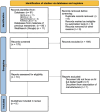AI Through Ethical Lenses: A Discourse Analysis of Guidelines for AI in Healthcare
- PMID: 38833207
- PMCID: PMC11150179
- DOI: 10.1007/s11948-024-00486-0
AI Through Ethical Lenses: A Discourse Analysis of Guidelines for AI in Healthcare
Abstract
While the technologies that enable Artificial Intelligence (AI) continue to advance rapidly, there are increasing promises regarding AI's beneficial outputs and concerns about the challenges of human-computer interaction in healthcare. To address these concerns, institutions have increasingly resorted to publishing AI guidelines for healthcare, aiming to align AI with ethical practices. However, guidelines as a form of written language can be analyzed to recognize the reciprocal links between its textual communication and underlying societal ideas. From this perspective, we conducted a discourse analysis to understand how these guidelines construct, articulate, and frame ethics for AI in healthcare. We included eight guidelines and identified three prevalent and interwoven discourses: (1) AI is unavoidable and desirable; (2) AI needs to be guided with (some forms of) principles (3) trust in AI is instrumental and primary. These discourses signal an over-spillage of technical ideals to AI ethics, such as over-optimism and resulting hyper-criticism. This research provides insights into the underlying ideas present in AI guidelines and how guidelines influence the practice and alignment of AI with ethical, legal, and societal values expected to shape AI in healthcare.
Keywords: AI ethics; AI guidelines; Artificial intelligence; Ethics; Guidelines; Healthcare; Regulations; Regulatory affairs.
© 2024. The Author(s).
Conflict of interest statement
The authors have no competing interests to declare that are relevant to the content of this article.
Figures
References
-
- Asimov I. I Robot. Berlin: Random House Worlds; 1950.
-
- Bareis J, Katzenbach C. Talking AI into being: The narratives and imaginaries of national AI strategies and their performative politics. Science, Technology, & Human Values. 2022;47(5):855–881. doi: 10.1177/01622439211030007. - DOI
-
- Bélisle-Pipon J-C, Monteferrante E, Roy M-C, Couture V. Artificial intelligence ethics has a black box problem. AI & Society. 2022 doi: 10.1007/s00146-021-01380-0. - DOI
Publication types
MeSH terms
Grants and funding
LinkOut - more resources
Full Text Sources
Medical


